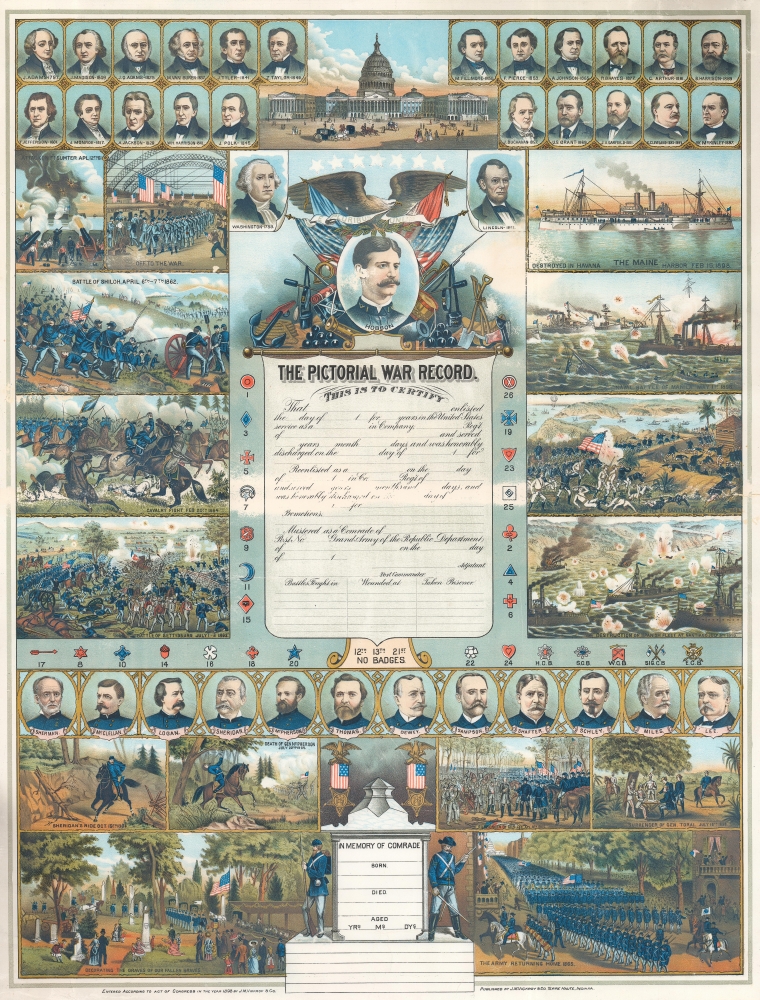1898 Vickroy Broadside Commemorating the Civil War and Spanish American War
PictorialWarRecord-vickroy-1898
Title
1898 (dated) 26 x 19.75 in (66.04 x 50.165 cm)
Description
A Closer Look
Of the 15 scenes commemorating the two wars, 10 illustrate events during the American Civil War. Beginning just below the presidential portraits on the left, the Civil War vignettes include the attack on Fort Sumter, the Battle of Shiloh, the Battle of Gettysburg, the death of General McPherson, the surrender of General Robert E. Lee, and the parade of the Grand Army of the Republic in Washington, D.C. The five vignettes of the Spanish-American War illustrated the U.S.S. Maine (which exploded in Havana Harbor on February 15, 1898, and ignited the war between Spain and the United States), the Battle of Manila, the Battle of Santiago, the destruction of the Spanish fleet at Santiago, and the surrender of General Toral.A section at center provides space for an individual to write their war record or that of a family member. This is surmounted by a portrait of Rear Admiral Richard P. Hobson (1870 - 1937), who was taken prisoner during the naval battle at Santiago, Cuba, and was later awarded the Congressional Medal of Honor. Portraits of President George Washington and President Abraham Lincoln appear above and to the left and right of Hobson. Portraits of the other U.S. Presidents up to President McKinley appear along the top. Below, a row of portraits of U.S. Civil War and Spanish American War generals and admirals is included.
Chromolithography
Chromolithography, sometimes called oleography, is a color lithographic technique developed in the mid-19th century. The process uses multiple lithographic stones, one for each color, to yield a rich composite effect. Generally, a chromolithograph begins with a black basecoat upon which subsequent colors are layered. Some chromolithographs used 30 or more separate lithographic stones to achieve the desired effect. Chromolithograph color can be blended for even more dramatic results. The process became extremely popular in the late 19th and early 20th centuries when it emerged as the dominant method of color printing. The vivid color chromolithography made it exceptionally effective for advertising and propaganda.Publication History and Census
This broadside was created and published by James M. Vickroy in 1898. We note a single cataloged example, which is part of the collection at the Library of Congress. We know of only one other instance of this piece entering the private market.Cartographer
James Monroe Vickroy (September 15, 1847 - October 14, 1913) was an American graphic artist. Born in Cumberland Valley Township, Pennsylvania, Vickroy started his professional life as a sales agent working for the M.C. Lilly Company of Columbus, Ohio, and sold ceremonial swords to secret fraternal organizations. At some point, Vickroy realized that he could take advantage of his talent as an artist and sell customized color lithographs to these fraternal orders. He married Elizabeth Enora Boor about 1875 and in 1876 the couple moved to Terre Haute, Indiana, where the first of their six daughters was born. Vickroy opened a chromolithograph business in Terre Haute in 1885, taking advantage of the at least 20 different secret societies and over 50 lodges to launch his business. He designed custom ledger books, certificates, and lithographs that he marketed to these societies, and by 1904 over 5,000 lodges used his Condensed Historical and Financial Ledger. Vickroy also designed genealogical charts, including 'The Afro-American History Record', which could be personalized. He also designed 'The Pictorial War Record', which was also meant to be personalized. More by this mapmaker...

